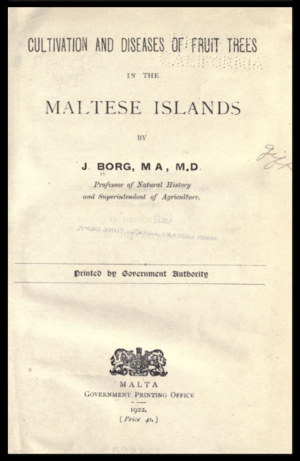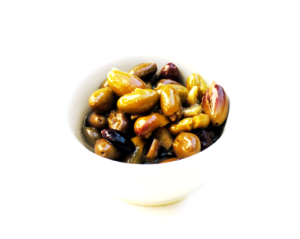Bidni facts for kids
Quick facts for kids Bidni |
|
|---|---|

Clusters of Bidni olives ripening on the tree
|
|
| Olive (Olea europaea) | |
| Color of the ripe fruit | Black |
| Origin | Malta |
| Use | Oil and table |
| Oil content | Low |
The Bidni (sometimes called Bitni) is a special type of olive tree that comes from the island of Malta in the Mediterranean Sea. Its olives are small, strong, and have a beautiful violet color. They are famous for making excellent olive oil that isn't very acidic. This good quality is often because of the unique soil in Malta.
The Bidni olive tree is native to Malta, meaning it has grown there for a very long time. It has its own special DNA and is thought to be one of the oldest types of trees on the island. Because of this, some of these ancient Bidni trees have been declared "national monuments" and are considered very important historical items. Only a few other plants in Malta have this special status.
Contents
What Does "Bidni" Mean?
Have you ever wondered where the name "Bidni" comes from? According to a dictionary called the "Maltese-English Dictionary," the word "Bidni" comes from "badan." This word means "corpulent," "robust," or "to grow stout." So, a Bidni olive tree is called that because it is a "corpulent" or strong, large tree, even though it produces very small olives.
This idea is different from some other theories. Some people online have suggested that the name "Bidni" came from a small village in Malta called Bidnija. Others thought it might mean "hunchback" in the Maltese language. But the dictionary suggests it's all about the tree's strong, big size!
What Makes Bidni Olives Special?
In 1922, a professor named John Borg wrote an important book about fruit trees in Malta. He was a Professor of Natural History and helped start the Government's Experimental Farm. He described the Bitni olive tree in his book:
The tree is a vigorous grower and of strong constitution. The leaves are broad and rather short, of a lively shining green colour on the upper surface. The fruit is very small, nearly elliptical, with a comparatively very small stone, and turns to a beautiful shining dark violet at maturity, which takes place towards the close of October or early in November. It is very rich in oil of excellent quality, but the fruit though very small is often pickled or salted and has a rich flavour free from bitterness. The fruit is produced in clusters, and the production is sometimes astonishing, the tree becoming literally black with fruit. The tree and its fruit are very resistant to disease, the fruit presents also the advantage that it is never attacked by the olive-fly Dacus Oleae and is therefore always allowed to ripen on the tree. This is a variety which seems to be best suited for large plantations, with a view to the production of oil.
—John Borg
Even today, scientists are amazed by how well the Bitni olive tree resists diseases. The Olive Oil Times newspaper called it a "peculiar local variety." This amazing ability might be due to high levels of special compounds called polyphenols in the Bidni olive. One of these, called oleuropein, is a natural antibiotic that helps protect the fruit and leaves.
The oil from Bidni olives is known for being "spicy" and "peppery." This unique taste helps it stand out from other olive oils. Once a Bidni tree is fully grown, it can produce a lot of olives, sometimes up to 60 kilograms (about 132 pounds) from just one tree!
Protecting Ancient Bidni Trees
Scientists have used carbon dating to figure out how old Malta's ancient Bidni olive trees are. While the exact dates are debated, some believe these trees date back to the 1st century A.D. (around 2000 years ago!). Others think they might be from the Medieval period.
Some Bidni olive trees in an area called Ġebel Għawżara have been protected since 1933. They are even listed in UNESCO's database of important cultural heritage laws. In 2011, local authorities recognized how important these trees are for history and the landscape. They noticed that only about 20 trees were left from 40 at the start of the 20th century. So, they declared this area a Tree Protected Area in 2018.
In 2021, two local groups were given the job of taking care of one of the olive groves in Bidnija. These highly protected Bidni olive trees can be very tall, sometimes between five and eight meters (16 to 26 feet) high! They still produce fruit and are often admired by visitors. You can also find other Bidni olive trees on private land near Qannotta Castle in Wardija.
Because the Government of Malta sees olive trees as a key part of the traditional landscape, you need a special permit to prune, cut down, or dig up any olive trees, including the Bidni kind.
The Bidni olive doesn't yet have a special "Protected Designation of Origin" (PDO) status. This status helps legally protect a product's name and shows where it comes from. However, there are projects, including studies on its DNA, to try and get this important certification. This would help market Bidni olive oil around the world.
Bringing Bidni Olives Back
In January 2006, a project called "PRIMO" (Project for the Revival of the Indigenous Maltese Olive) was started. One of PRIMO's main goals was to bring back native olive types like the Bidni. They also wanted to greatly increase how many Bidni olives were produced. This would help them get that special "Protected Designation of Origin" (PDO) status.
Thanks to PRIMO, about 30,000 new Bidni olive trees were planted. This helped create the foundation for a new local industry. Here's how they did it:
- First, they collected olive seeds from the ancient Bidni olive grove in Bidnija.
- These seeds were then planted at the Government of Malta's Experimental Farm in Għammieri. They were left to grow into small plants called "rootstocks."
- Once the rootstocks were strong enough, small branches were taken from the very old Bidni olive trees.
- These branches were then carefully grafted (joined) onto the new rootstocks.
Efforts to plant even more Bidni olive trees are still happening today!
Bidni Olives in Maltese Food
Maltese people love to use olive oil in their cooking. In fact, in 2012, Malta ranked 8th in the world for how much olive oil each person used! People in Malta have been using olive oil for a very long time, possibly even before the Roman Empire. It's a big part of their daily meals.
For example, in 1804, a French writer named Louis de Boisgelin wrote that the Maltese often ate "a clove of garlic, or an onion, anchovies dipped in oil, and salted fish." Even today, olive oil is very important in Maltese food. A popular Maltese snack called "ħobż biż-żejt" literally means "bread with oil," showing just how much they love it!
While the Bidni olive is best known for its amazing oil, the small olives can also be eaten directly. One popular way is to crush Bidni olives in extra virgin olive oil that has garlic in it. Then, you eat them with Maltese bread. Another way is to gently fry Bidni olives after they've been preserved in brine (saltwater). You can then serve them with fresh herbs like parsley or mint.
Even the leaves of the Bidni tree have been used! People have made tea from them, which some believe can help lower high blood pressure. This old remedy is still used in some rural parts of Malta.
Images for kids
See also
 In Spanish: Bidni para niños
In Spanish: Bidni para niños








